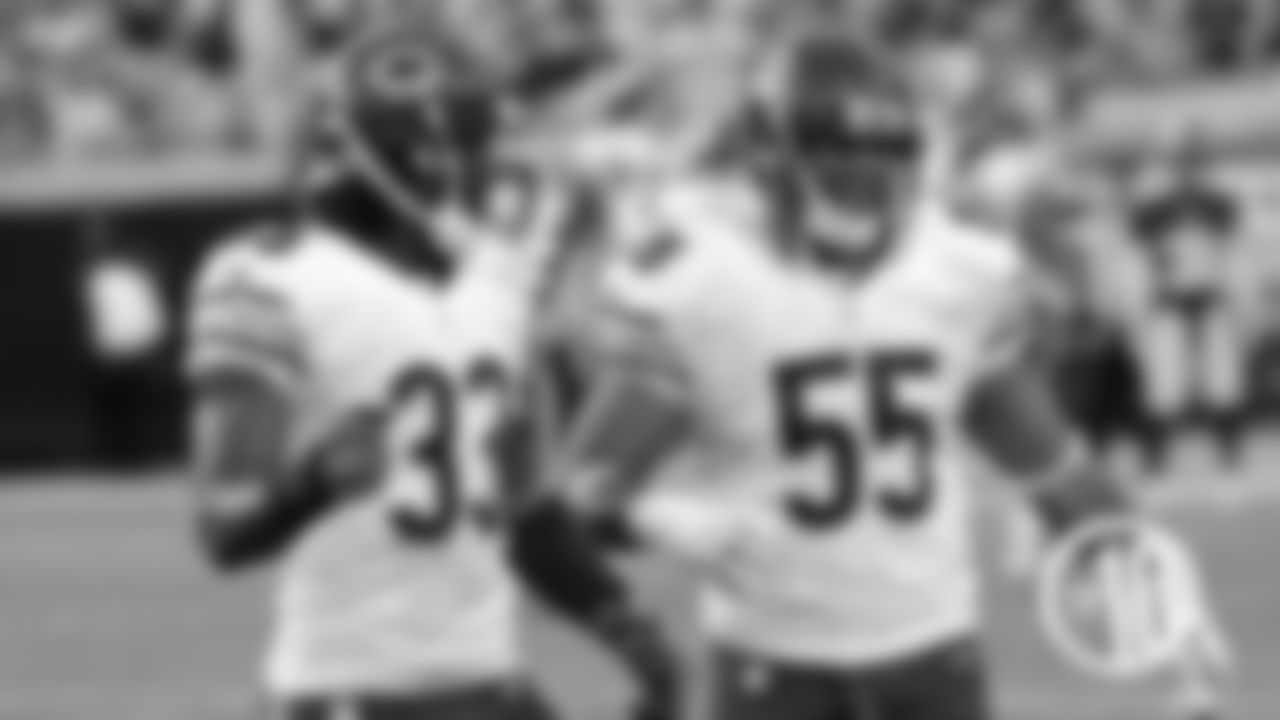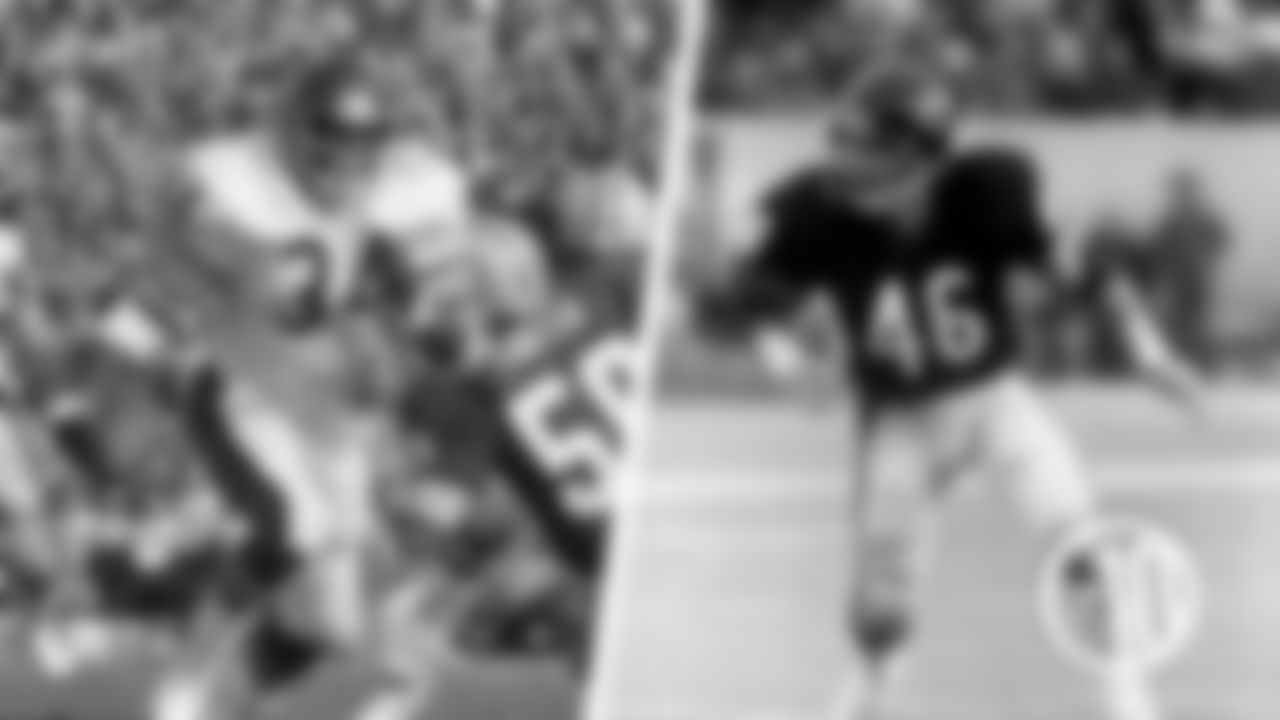In the fifth of a five-part series counting down the best drafts in Bears history, I've ranked the 1983 crop at No. 1. Here's why:
With two first-round picks, the Bears entered the 1983 NFL Draft with high expectations. Twelve rounds later, they had harvested seven eventual starters who in two years would help lead the franchise to its first Super Bowl title.
The draft class was highlighted by a pair of Hall of Famers in first-round tackle Jimbo Covert and eighth-round defensive end Richard Dent. The Bears also selected receiver Willie Gault in the first round, cornerback Mike Richardson in the second, safety Dave Duerson in the third, guard Tom Thayer in the fourth and guard Mark Bortz in the eighth.
The Bears chose Covert with the sixth overall pick, two slots after the player that they had been targeting, Northwestern offensive lineman Chris Hinton, was chosen by the Broncos.
Before taking Covert, Bears general manager Jim Finks had considered Clemson safety Terry Kinard, who went 10th to the Giants; and Illinois quarterback Tony Eason, who went 15th to the Patriots.
Quarterback Jim McMahon, the Bears' first-round pick the previous season, wondered why the team was looking at Eason. "I plan on playing, so I don't know what they would have done with him," McMahon said after the draft.
The Bears selected Gault at No. 18 after the Falcons chose Alabama defensive end Mike Pitts at No. 16 and the St. Louis Cardinals picked McNeese State safety Leonard Smith at No. 17.
McMahon was more pleased with the arrival of Covert than Gault. "What good is a fast receiver if you can't set up and throw it to him?" he said.
Covert, who blocked for Hall of Fame quarterback Dan Marino at the University of Pittsburgh, anchored a stellar Bears offensive line for eight seasons. Covert was named to the NFL All-Decade Team for the 1980s and will be enshrined in the Hall of Fame later this year.
"He's good at setting up short and stopping ends from the left side," then-coach Mike Ditka said the day Covert was drafted. "In films, he looks like he was toying with people."
Gault, a world-class sprinter from Tennessee who was the first receiver chosen in the 1983 draft, caught 184 passes in five seasons with the Bears. He currently ranks ninth on the club's all-time list with 3,650 receiving yards and eighth with 27 touchdown catches.
"We had problems with the way people played us outside last year," Ditka said at the time. "We think Willie can have the same impact on the Bears as Bob Hayes had on the Cowboys and James Lofton had on the Packers. We're looking to become a fast football team."
In the days leading up to the draft, the Los Angeles Raiders had been trying to trade for the Bears' No. 6 pick. The Raiders wanted to use the pick as part of a package to acquire the first overall selection from the Baltimore Colts to land Stanford quarterback John Elway.
But the deal fell through, reportedly because the Raiders felt that the Bears were asking for too much in return. Owner Al Davis denied speculation that the Raiders had offered future Hall of Fame defensive tackle Howie Long and cornerback Ted Watts for Chicago's No. 6 pick.
In Richardson, the Bears chose an athlete "with great presence," according to scout Jim Parmer. Primarily a safety at Arizona State, Richardson made a successful transition to cornerback in the NFL.
Covert, Gault and Richardson all were immediate starters for the Bears.
Duerson was a versatile four-year starter at Notre Dame. He was initially projected as a cornerback, but he remained at safety and was selected to four Pro Bowls in seven seasons with the Bears.
The Bears were embarrassed to learn that they had drafted Thayer a few hours after he had signed with the Chicago Blitz of the rival United States Football League. But the Joliet product eventually joined the Bears in 1985 and started for the Super Bowl champions.
The Bears had traded away their picks in the fifth, sixth and seventh rounds, so they sat and watched before striking gold twice in the eighth round.
Scout Bill Tobin said that Dent was the best pure pass rusher he had graded. But Dent hadn't played against top competition at Tennessee State. He also weighed just 224 pounds due in part to a problem with his teeth that limited what he could eat.
Dent developed into a monster pass-rusher with the Bears, becoming the franchise's all-time leader with 124.5 sacks. He was named MVP of Super Bowl XX and inducted into the Hall of Fame in 2011.
Bortz also emerged as a draft steal who was ultimately voted to two Pro Bowls. Called "tough and a battler" by Ditka, Bortz was converted to offense after playing defensive tackle at Iowa and teamed with Covert, Thayer, center Jay Hilgenberg and right tackle Keith Van Horne to form one of the best offensive lines in NFL history.
Bears 1983 draft class
1-6: Jimbo Covert, OT, Pittsburgh
1-18: Willie Gault, WR, Tennessee
2-33: Mike Richardson, CB, Arizona State
3-64: Dave Duerson, S, Notre Dame
4-91: Tom Thayer, G, Notre Dame
4-107: Pat Dunsmore, TE, Drake
8-203: Richard Dent, DE, Tennessee State
8-219: Mark Bortz, G, Iowa
9-230: Rob Fada, G, Pittsburgh
9-235: Mark Zavagin, LB, Notre Dame
10-256: Anthony Hutchinson, RB, Texas Tech
11-286: Gary Worthy, RB, Wilmington
12-313: Oliver Williams, WR, Illinois
With the 2020 NFL Draft set to kick off in just over two weeks, senior writer Larry Mayer ranks the top 10 drafts in Bears history.

(10) 1954
The Bears landed two key offensive stars in the 1954 draft in second-round fullback Rick Casares and 15th-round receiver Harlon Hill. Casares played 10 seasons with the Bears, rushing for 5,675 yards and 49 touchdowns on 1,386 carries. He was the franchise's all-time leader rusher until he was surpassed by Walter Payton in 1979. Hill spent eight seasons with the Bears. He was voted NFL Rookie of the Year in 1954, became the first winner of the Jim Thorpe Trophy as league MVP in 1955, and was a three-time All Pro selection.

(9) 2003
The Bears spent second- and third-round picks in 2003 on cornerback Charles Tillman and linebacker Lance Briggs, who helped fuel a defense that led the team to three NFC North titles in six seasons from 2005-10. In consecutive road wins over the Cowboys and Jaguars in 2012, Tillman and Briggs became the first teammates in NFL history to both return interceptions for touchdowns in back-to-back games.

(8) 2000
The Bears hit back-to-back home runs in the first two rounds of the 2000 draft when they selected Hall of Fame middle linebacker Brian Urlacher at No. 9 and safety Mike Brown at No. 39. Urlacher was the face of the franchise for more than a decade, earning eight trips to the Pro Bowl and the 2005 NFL defensive player of the year award. Brown was the heart-and-soul of the defense; a two-time All-Pro who recorded 17 interceptions with the Bears.

(7) 1939
Before the 1938 season, the Bears traded end Edgar "Eggs" Manske to the Steelers in exchange for their first-round pick in 1939. The Bears used the selection to choose Hall of Fame quarterback Sid Luckman second overall. Luckman led the Bears to four league titles and helped revolutionize pro football by helping to introduce the "T" formation. The Bears also landed fullback Bill Osmanski with the sixth pick in the first round and guard Ray Bray in the ninth round.

(6) 1940
The Bears selected Hall of Fame center/tackle/linebacker Clyde "Bulldog" Turner with the seventh pick in the first round of the draft. An eight-time first-team All-Pro, Turner helped the Bears win four NFL championships in his first seven seasons and remained with the team through 1952. The Bears also spent a second-round pick on receiver Ken Kavanaugh, who remains the franchise's all-time leader with 50 touchdown receptions.

(5) 1981
First-round right tackle Keith Van Horne started 169 games over 13 seasons with the Bears on some of the best offensive lines in NFL history. Fourth-round safety Todd Bell also thrived before sitting out the 1985 season due to a contract dispute. But the key to the 1981 draft was the selection of Hall of Fame middle linebacker Mike Singletary in the second round at No. 38 overall.

(4) 1975
The Bears selected the great Walter Payton with the fourth overall pick in the first round. But Sweetness was just one of nine players from the '75 draft who would eventually become a starter. The crop included a pair of steals in safety Doug Plank in the 12th round and fullback Roland Harper in the 17th round.

(3) 1936
The Bears landed two Hall of Famers in the very first NFL draft when they picked offensive linemen Joe Stydahar in the first round and Danny Fortmann in the ninth round. Playing next to each other on the left side of the Bears offensive line, Stydahar and Fortmann helped the "Monsters of the Midway" revolutionize the NFL with the T-formation.

(2) 1965
The Bears selected a pair of legendary Hall of Famers in middle linebacker Dick Butkus and running back Gale Sayers with back-to-back picks in the first round at Nos. 3 and 4. Both are considered among the greatest players to ever line up at their respective positions. The '65 draft also produced receiver Dick Gordon in the seventh round.

(1) 1983
The 1983 draft produced seven starters on the 1985 Super Bowl championship team, including Hall of Famers Jimbo Covert in the first round and defensive end Richard Dent in the eighth round. The impressive haul also included Willie Gault, Mike Richardson, Dave Duerson, Tom Thayer and Mark Bortz.















